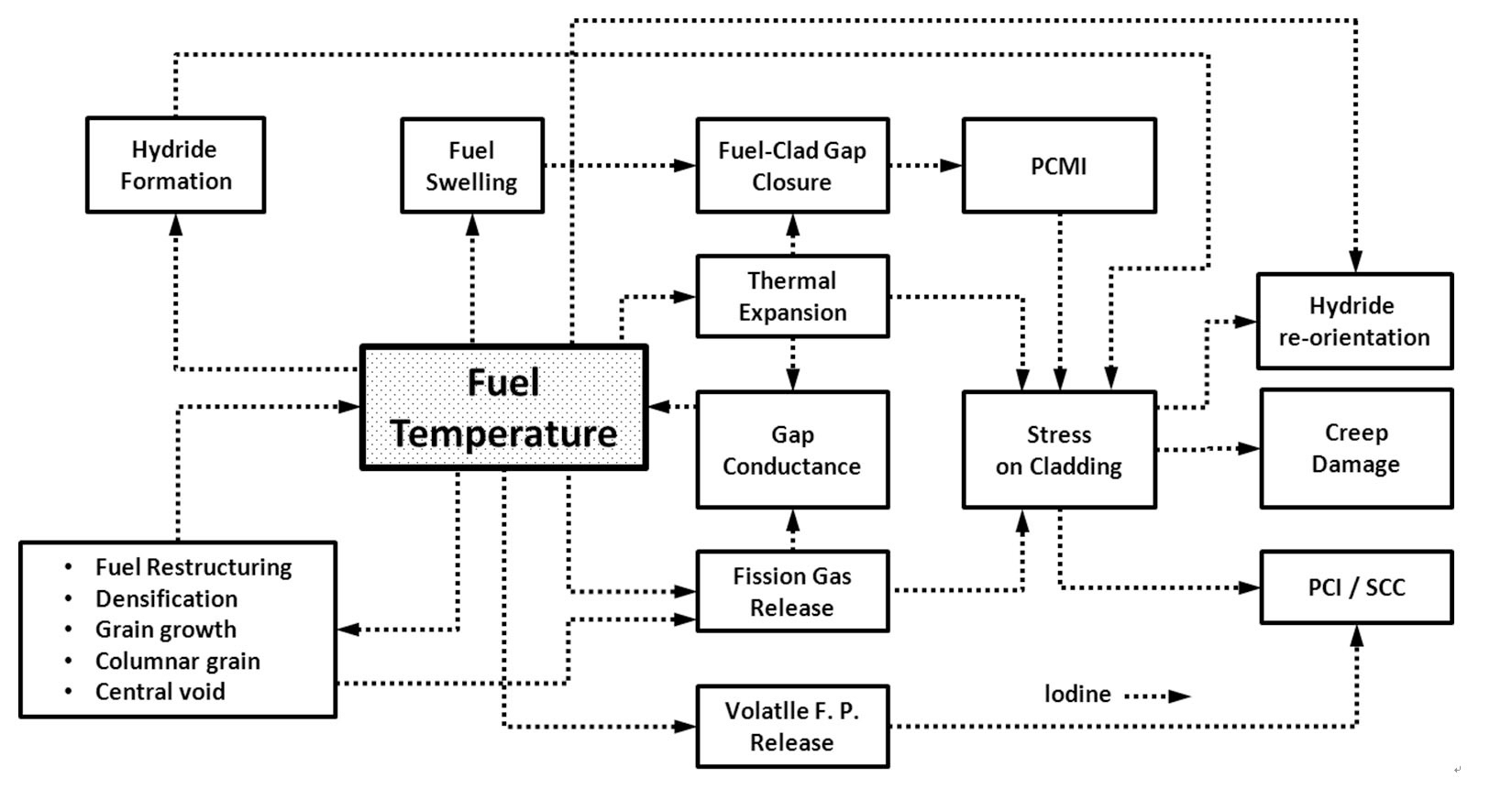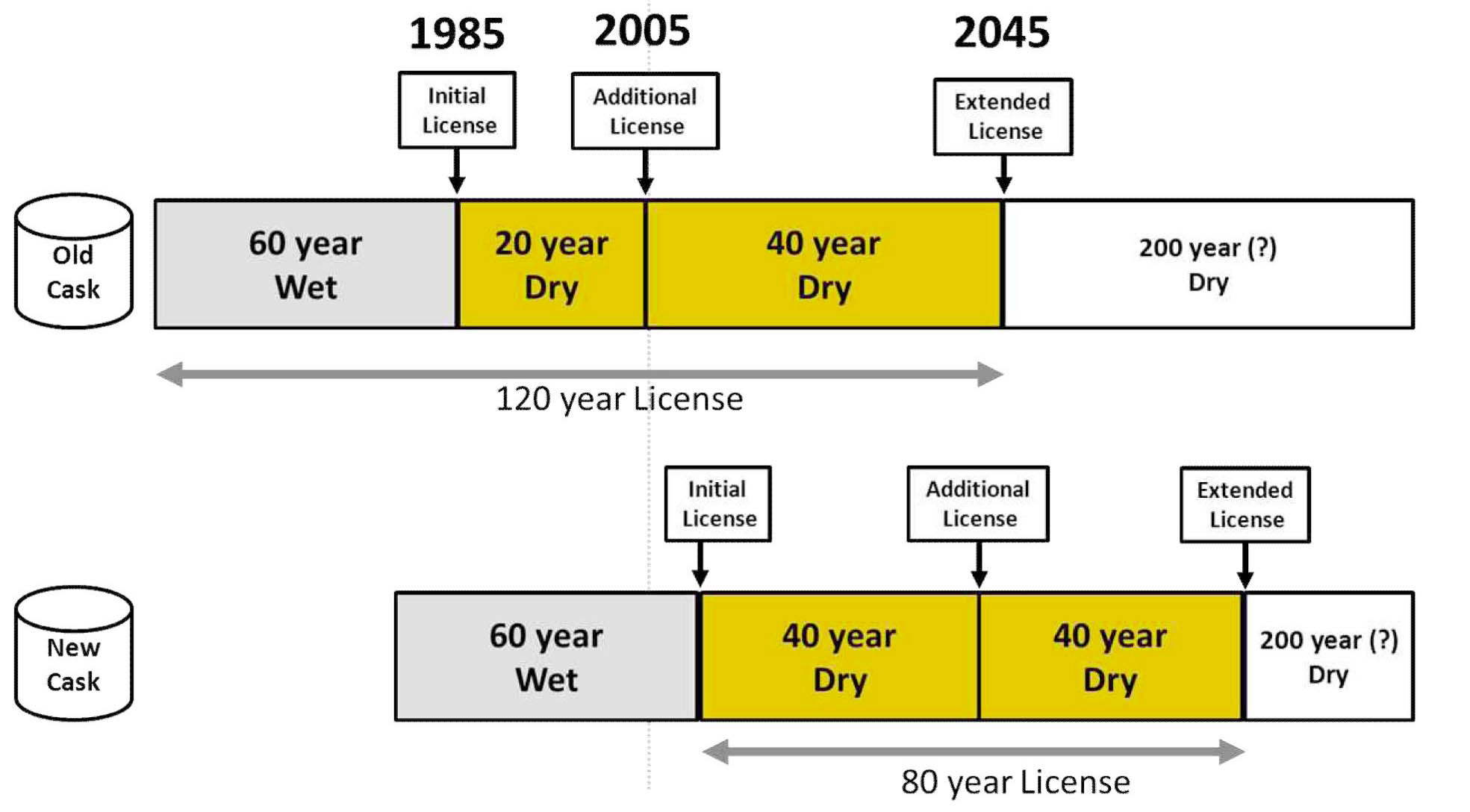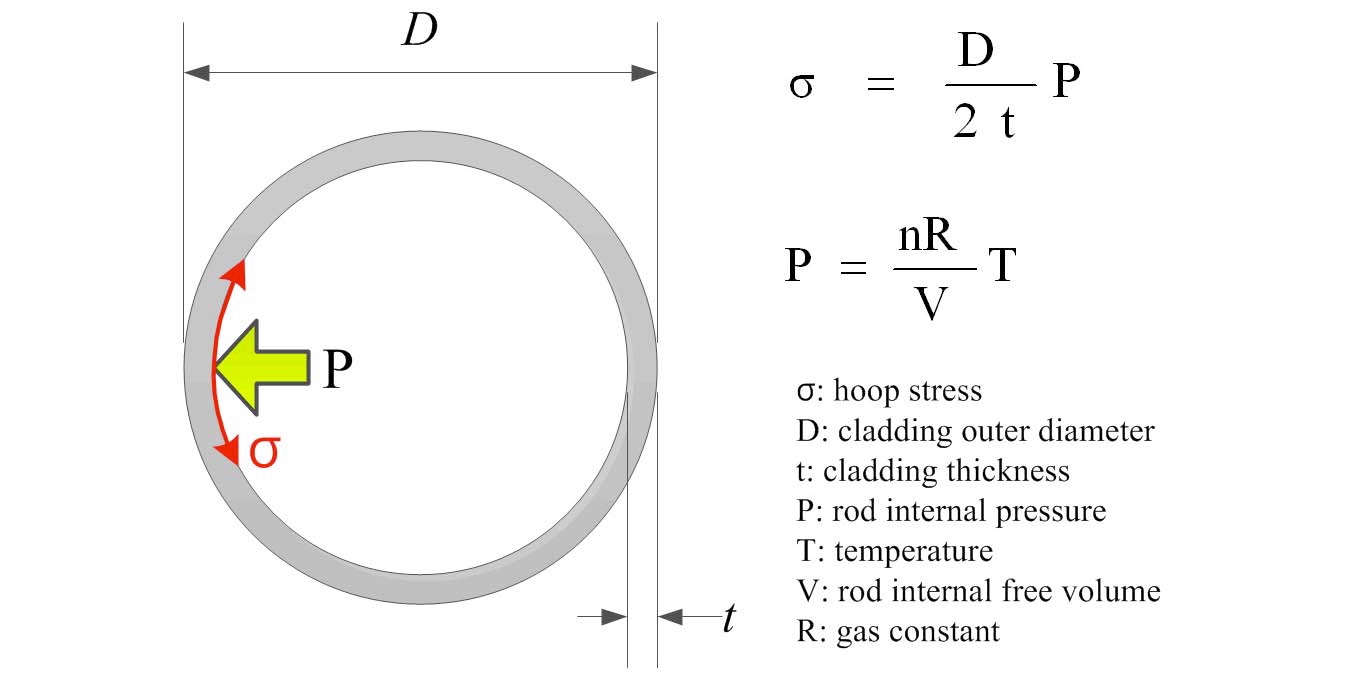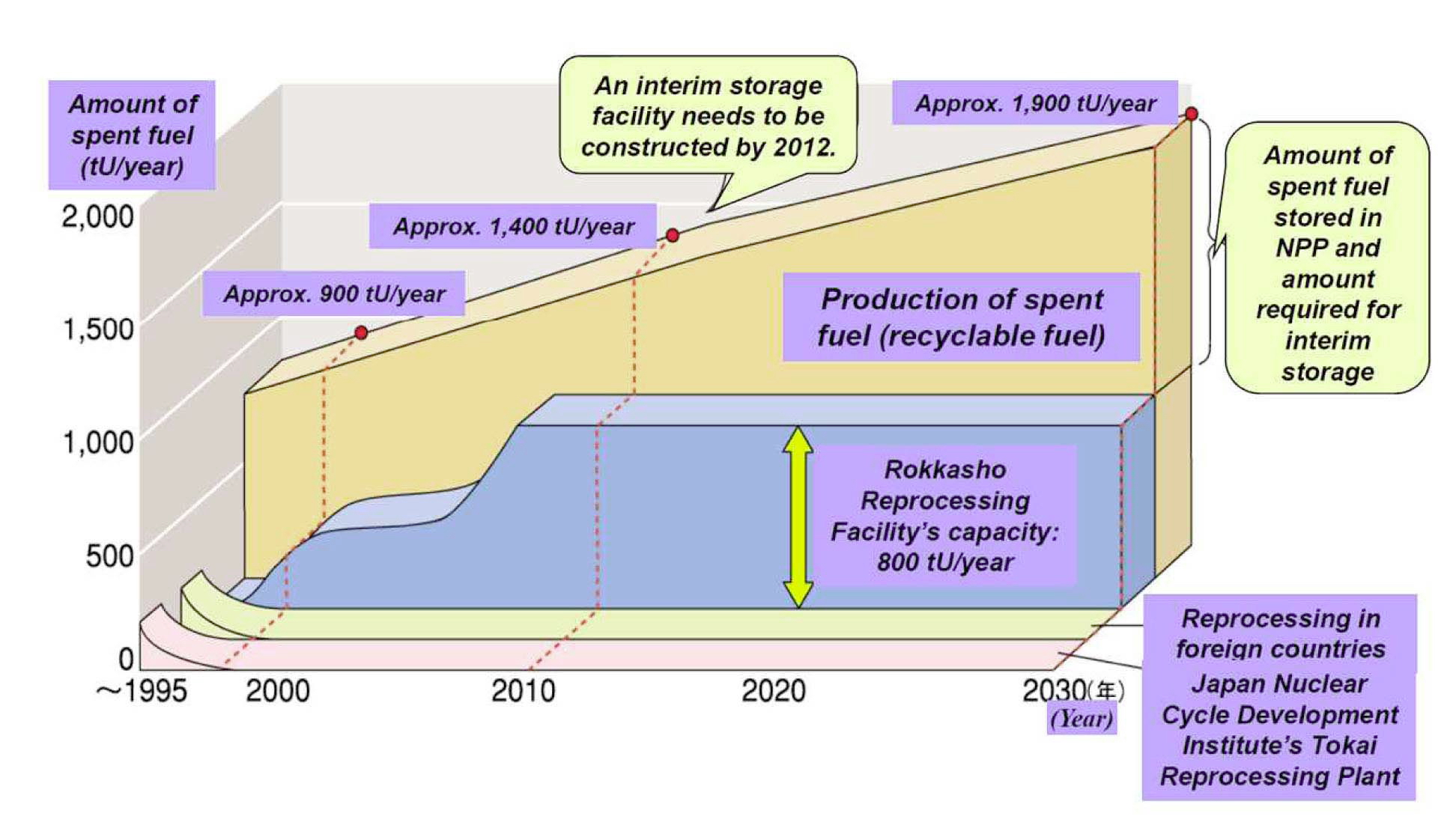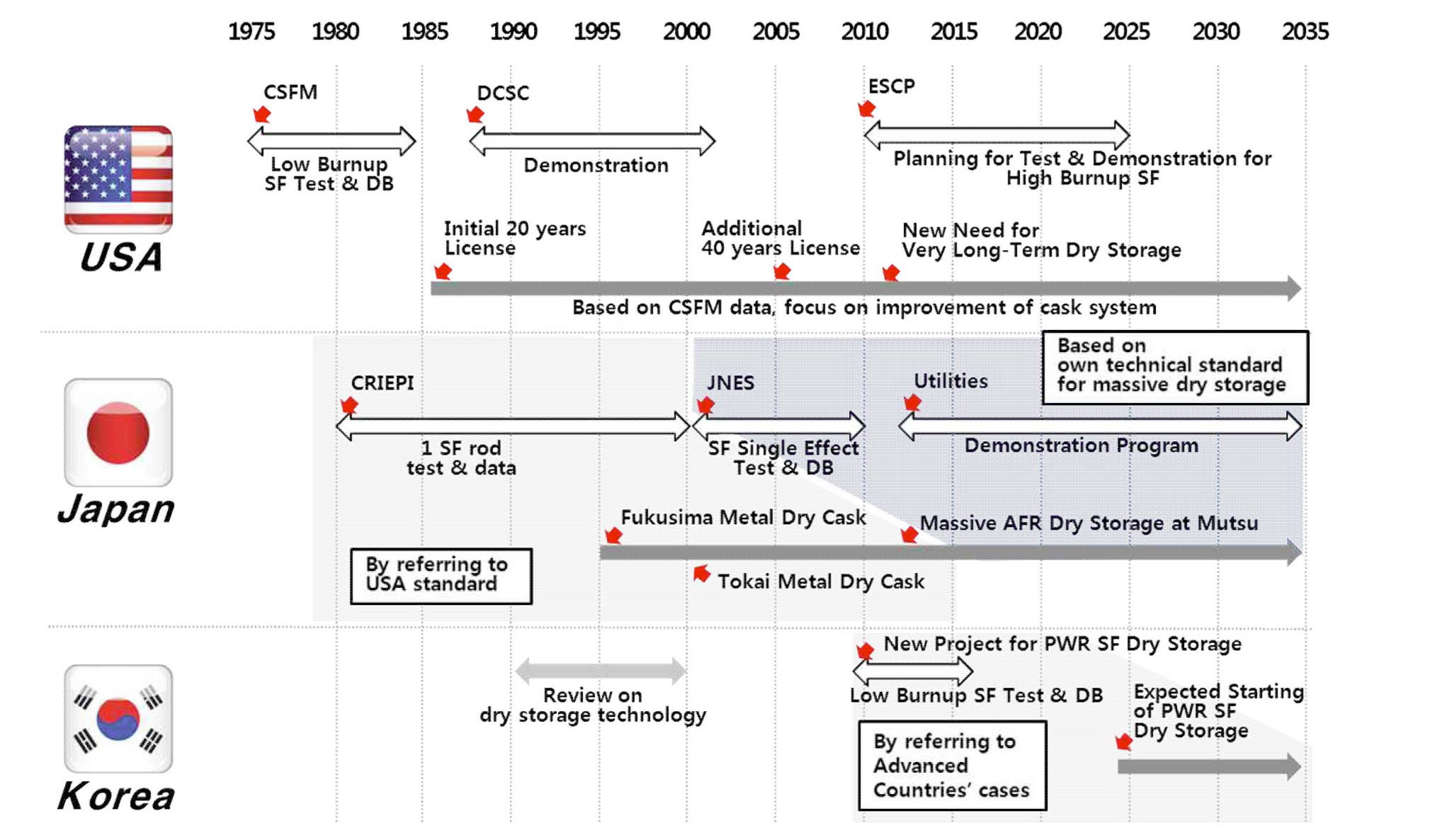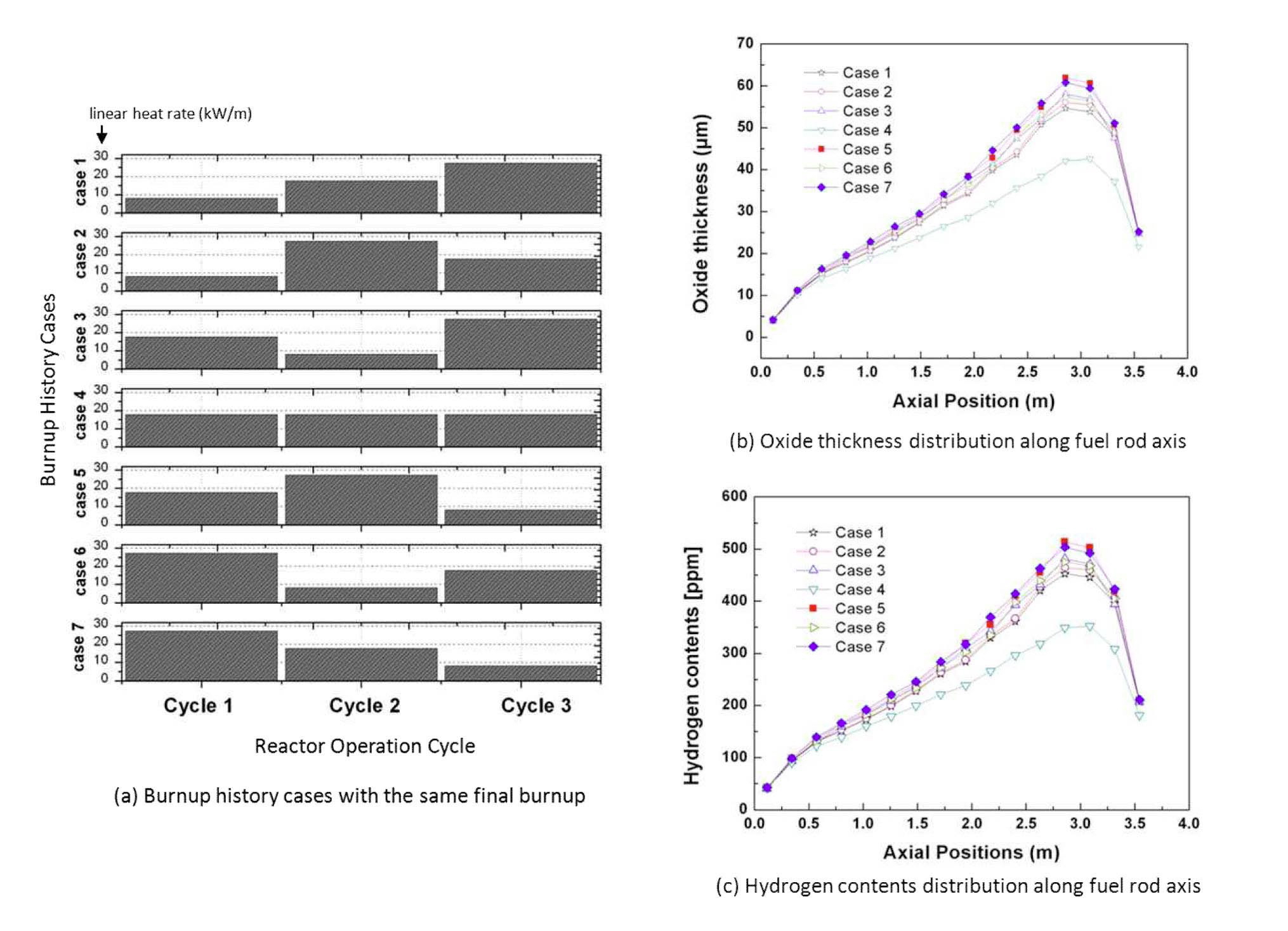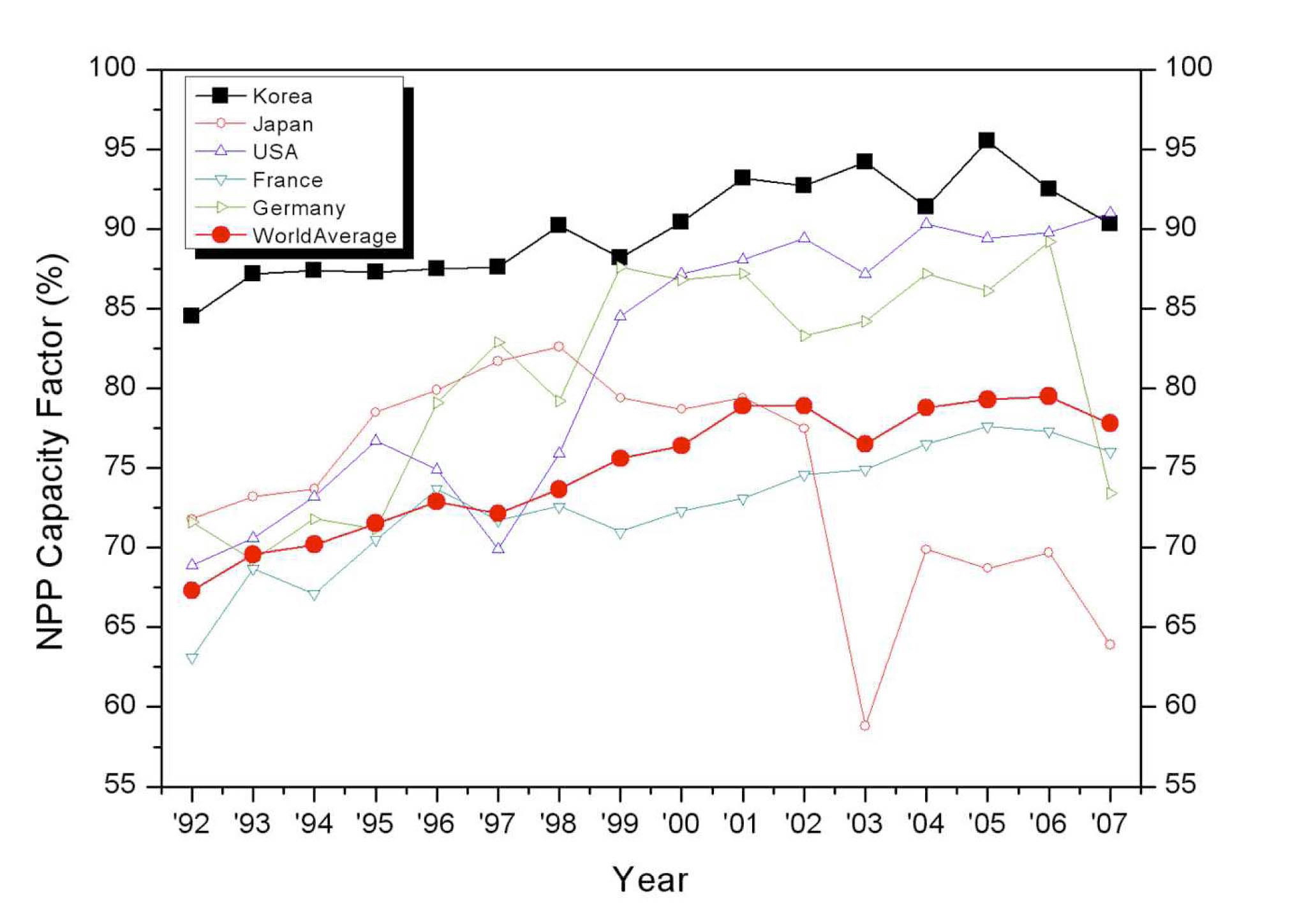



Recently, spent fuel dry storage demands, rather than wet storage, are continuously increasing in other nuclear countries owing to various advantages such as easy system installation, expandability, transportability, economical efficiency, safety, and public acceptance. According to the latest announcement of the government [1] which includes an expansion plan of nuclear power up to 59%, the spent fuel accumulation problem will be more severe in Korea. Among the several available alternative options to solve this problem, dry storage could be most realistic and possible in the near future because of the limited space in spent fuel pools for transshipment between nuclear power plants, the uncertainty of the pyro process success at the commercial scale, which needs to be further developed over a long period, and the obscurity of the deep disposal implementation schedule, which is the last procedure scheduled following the others [2].
1.2 Spent Fuel Integrity Evaluation
The ultimate objectives of spent fuel dry storage are to prevent a gross rupture of the spent fuel during operation and to keep its retrievability until transportation because storage implementation was born conceptually as an intermediate method before a permanent decision [3]. These objectives have led to active spent fuel integrity evaluation research prior to storage system development. Among the main safety evaluation items of dry storage system including structure, confinement, shielding, criticality, thermal, and material degradation, the last two items are directly related to spent fuel integrity. In particular, the peak rod temperature in the dry storage system has a great influence on the system design criteria and is the only controllable parameter in a passive cooling system such as dry storage. Fig. 1 shows the relationships among the various nuclear fuel degradation mechanisms, which are established based on the key role that fuel temperature takes. In a dry storage condition, this dependency on fuel temperature can be more dominant because other mechanisms except creep and hydrogen effect had already stopped its progression after reactor operation.
Fuel temperature and burnup can play a key role in determining the oxide layer thickness, hydrogen pickup fraction, fission gas release rate, rod internal pressure, and hoop stress on the inner cladding wall. The cladding material condition, which is determined by the reactor’s operation history, is also again becoming dependent on the storage temperature history. All efforts for calculating the temperature of all system components are focused on lowering the fuel temperature under the safety criteria, which
were established through spent fuel integrity evaluations. Therefore, in this work, it is very important to estimate the actual fuel cladding temperature as precisely as possible and evaluate the remaining engineering margin of the cladding within a target dry storage operation lifetime [4].
2. STATUS OF SPENT FUEL INTEGRITY EVALUATION IN ADVANCED COUNTRIES
Germany and the USA have performed spent fuel integrity evaluation since the middle of the 1970’s, just after cancelling the reprocess policy for spent fuel management. They established almost the same peak rod temperature criteria methodologies for a dry storage system based on 10 years of research results, and applied this criteria to a commercial dry storage system, which started in 1985 [5]. Recently, Japan has also performed spent fuel integrity evaluation for almost 10 years to establish its own criteria methodology before building the massive AFR dry storage in Mutsu city. By understanding their background, comparing these old and new methodologies, referring to their results, and considering specific domestic situations, it is necessary to shape Korea’s own methodology.
2.1.1 Historical Changes of Spent Fuel Management Policies
After abandoning reprocessing, a deep repository has
been the national policy for commercial spent fuel management in the USA. However, dry storage, which was an inevitable option until the Yucca mountain repository open, has grown beyond its initial 20 year operation lifetime owing to a repository project delay. The Dry Cask Storage Characterization (DCSC) project [6] supported additional 40 year lifetime extension in 2005 for existing dry storage systems (ISFSIs) by inspecting the spent fuel and dry storage system, which had been in operation for about 14.5 years in the field. The best pursuable basis for 40 year extension is that initial 20 years of spent fuel may be in its most dangerous time in terms of radiation and decay heat level, and that the existing dry storage facilities have already passed this critical time frame. The whole storage activities of spent fuel includes currently 60 years in wet storage, according to the nuclear reactor building license, 20 years in an initial dry storage, and more 40 years in additional dry storage. Relatively new dry storage systems, which started operation after 2005, have only a 40 year license, and another 40 year extension is being considered. High burnup spent fuel dry storage system has been licensed for 20 years from 2005. Suspension of the Yucca Mountain Project (YMP) in 2010 [7] forced the Blue Ribbon Commission [8] to find another good alternative idea and the stakeholders to consider an extremely very long term dry storage beyond 120 years [9]. Fig. 2 shows a conceptual diagram of the historical changes in the spent fuel dry storage license in the USA. Fig. 3 shows the change of spent fuel dry storage demand after the YMP cancellation in the USA [10].
2.1.2 License Scheme in the USA
The technical criteria on the spent fuel dry storage in the USA are based on 10CFR72, and there are two kinds of licenses; ‘Site specific License (SL) [11]’ and ‘General License (GL) [12]’. The most noticeable differences between these two license systems are in the matter of a ‘public hearing process’ and a ‘Certificate of Compliance (CoC)’. There are a large amount of requirements for a SL, such as a nuclear power plant operation license, which includes a ‘site specific’ analysis of the surrounding environments. A SL also requires a public hearing process around the site, and therefore, a utility sometimes has to modify the spent fuel dry storage system based on the public willingness. On the other hand, a GL uses a ‘CoC’ philosophy, which means that if a dry storage system vendor acquires a ‘CoC’ for a given system from the US NRC by an independent approval process before the system is sold to the utility, this ‘CoC’ removes the need for a public hearing, and therefore, the utility only needs to buy a system to their taste and install it in their nuclear power plant site without any public hearing process. Based on the ‘CoC’ strategy, the GL process provides convenience, flexibility, shorter installation time, and economical advantage. For these reasons, the GL is recently more dominant in the USA except very unique cases like earthquake zones.
2.1.3 Methodology Changes of Spent Fuel Integrity Evaluation
Spent fuel integrity research in the USA was led by the Commercial Spent Fuel Management (CSFM) [13] program in the 1970’s-80’s. As a final result, creep was considered as the most important degradation mechanism for cladding integrity in dry storage by referring to creep and creep rupture maps [14]. To prevent creep from progressing, independent storage temperatures have been suggested depending on the spent fuel species, cladding materials, burnup levels, and charging gases in the storage system, and these various temperature limits for each system were applied until 1997 [15]. The initial NUREG -1536 report, published in 1997 [16], included Diffusioncontrolled Cavity Growth (DCCG) as an important cladding degradation mechanism. However the Interim Staff Guide (ISG)-11, published in 1999, which was used to supplement NUREG-1536, excluded DCCG because of its extremely low occurring possibility in dry storage operation and used ‘low burnup spent fuel’ to represent lower than 45,000 MWd/MtU burnup spent fuels. The revised ISG-11 (Rev. 1) in 2000 considered the oxide layer thickness and restricted less than 1 % creep of spent fuel cladding [17]. The secondary revision, ISG-11 (Rev. 2) in 2002, noticed that while creep is the most important degradation mechanism of spent fuel cladding in dry storage, it does not appear to be a critical threat to spent fuel integrity as it shows a selflimiting phenomenon. The temperature of a spent fuel dry storage system decreases at a very slow rate over its lifetime and this almost near constant value (T) for a short range time sets the right-hand side of the well-known Eq. (1) constant. As the creep progresses further, the volume of the fuel rod (V) will be expanded, yet on the other hand, the internal pressure of the fuel rod (P) has to decrease owing to the constant value on the right side. This decreased internal pressure does not push the fuel rod wall any more like in the previous step, and therefore, creep can be called a self-limiting mechanism.
Based on experience for dry storage operation, the second revision of ISG-11 (Rev. 2) suggested a uniform temperature limit for cladding. This uniform temperature (400 ℃) has a little more thermal margin than the previous storage systems, which have a specific system-inherent temperature limit around 340~380 ℃ range values determined by the peak rod temperature calculation methodology regarding the characteristics of the target spent fuel to be stored. This higher temperature is interpreted as a buffer for an uncertainty of merging various temperature criteria on several zirconium-based alloys and gives the system designers & the operators greater engineering margin. At the same time it also gives the regulators more convenience for the review process. The restricted temperature range within 65 ℃ for the repeated thermal cycling which is needed for hydride precipitation supersaturation in a short thermal cycle was also suggested to limit the decreases in ductility and fracture toughness that may be associated with hydride reorientation in this version.
The third revision of ISG-11 (Rev.3) in 2003 [18] clarified the maximum number of thermal cycling as less than 10 cycles based on technical research work by Kammenzind [19]. This was suggested to prevent any breakage during a transient situation such as transportation since this thermal cycling can cause radial (re-oriented) hydride formation which makes the cladding vulnerable to impact. For less than 45,000 MWd/MtU burnup spent fuel, other criteria was suggested as an alternative to the unified temperature( 400 ℃) based on unirradiated cladding research work by Kese [20]; a higher short-term temperature above (400 ℃) could be applied as long as the best estimate cladding hoop stress is equal to or less than 90 MPa. This limitation for hoop stress on cladding was intended to preclude the formation of radial hydrides. However, according to Fig. 4, because hoop stress is directly related to temperature, the above new suggestion just offer a selective preference to regulation reviewer.
The technical bases report [21] suggested the most considerable degradation mechanisms for fuel and cladding for additional storage (40 years from 2005), which are listed on Table 1. This table shows that a number of considerable degradation mechanisms for additional storage was reduced, and that it focuses on off-normal and accident conditions. Moreover, the hydride effect is becoming important as the storage system temperature decreases. In this table, we can find which degradation mechanism can be dominant in each time frame using the temperature range
[Table 1.] Considerable Degradation Mechanism for Additional Storage.
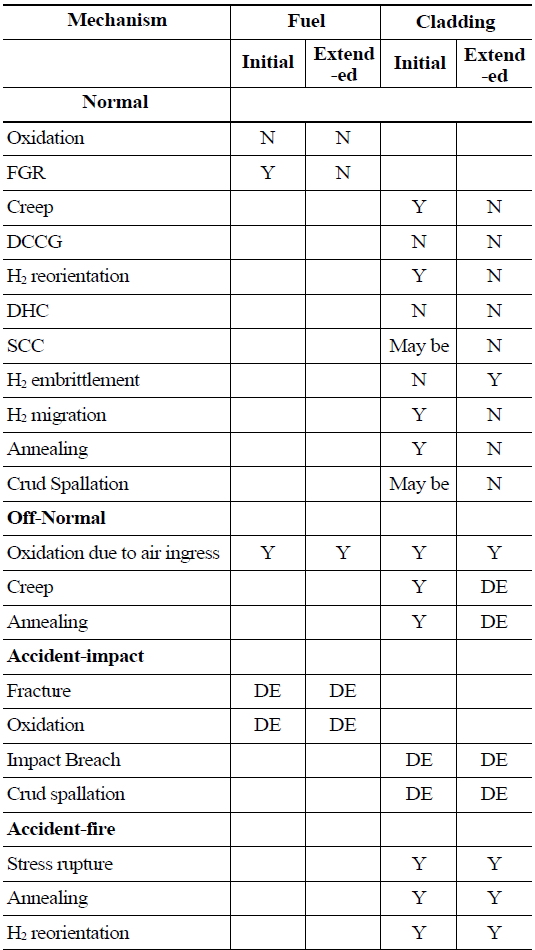
Considerable Degradation Mechanism for Additional Storage.
for that time, and realize that the fuel pellet has no problem and creep is no longer critical in additional storage, and recognize that because of transportation at the end of storage, cladding degradation induced by hydride is increasing in importance as time goes by and the system temperature drops. In 2010, NUREG-1536 Revision 1 was published, which reflected all previous technical changes and categorized the operation mode as normal, off-normal, and accident. An off-normal condition conceptually means ‘once per year’, and an accident condition conceptually means ‘once per system lifetime’ from a probabilistic point of view. This revision has also deployed the risk assessment concept to regulator’s reviewing process by classifying all check points as high, medium, or low level. This risk assessment concept for every dry storage ‘system, structure and components’ (SSC) has been popularly applied to an ‘extended storage gap analysis’, which is a hot issue in the USA.
2.1.4 Recent Tendency for Extended Storage
Recently a very long-term (extended) storage movement of over 120 years had led to a new research necessity for spent fuel integrity evaluation. Table 2 compares the spent fuel research work area of the initial and extended storage periods briefly.
Considering extended storage, several blind points of the DCSC project implementation have been brought to light, and the belief of the most dangerous initial 20 years of spent fuel in dry storage has been challenged owing to the significant hydride effect in low temperature ranges for the remaining 40 years [22]. To solve these problems or challenges of extended storage, technical gap analysis of research between the initial dry storage and new extended storage has been performed by 4 organizations independently [23]. Table 3 summarizes the draft prioritizations of the research items for major SSCs except the Nuclear Waste Technical Review Board (NWTRB). Focusing on spent fuel related items, fuel pellet is not important, and on the other hand, cladding degradation mechanisms related to the hydride effect as the system temperature
[Table 2.] Comparison of Spent Fuel Research between Initial and Extended Storage.
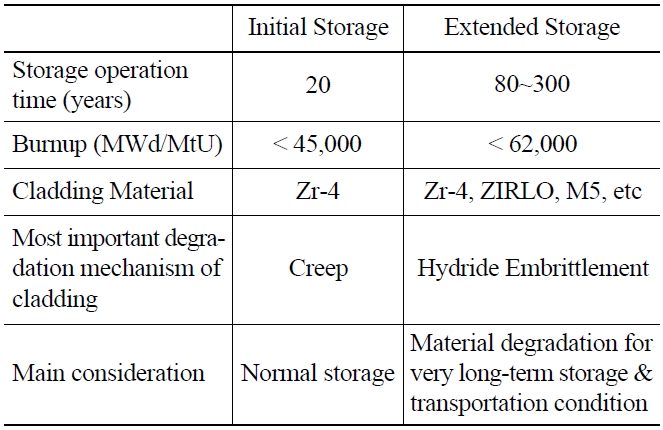
Comparison of Spent Fuel Research between Initial and Extended Storage.
drops with time are the main issue for extended storage [24][25].
The new necessity for spent fuel integrity research on extended storage includes a long-term full-scale demonstration using the high burnup spent fuels [26]. Active and deep opinions about this are discussed through the Extended Storage Collaboration Program (ESCP), which has been led by EPRI [27]. Moreover, Used Fuel Disposition (UFD) which has been led by the US DOE is considering spent fuel management in the big picture including storage, transportation, and disposal [28]. This program is also participating in data acquisition examination of high burnup spent fuel and a joint demonstration with ESCP. These activities are expected to produce reliable research results for the listed items in Table 3.
Based on a reprocessing policy for spent fuel in Japan, several consignments of spent fuel reprocessing in other countries have been accomplished until 2003, and a new domestic reprocessing facility, the Rokkasho Reprocessing Plant (RRP), has not yet started its commercial operation
[Table 3.] Summary of Technical Gap Analysis Results.
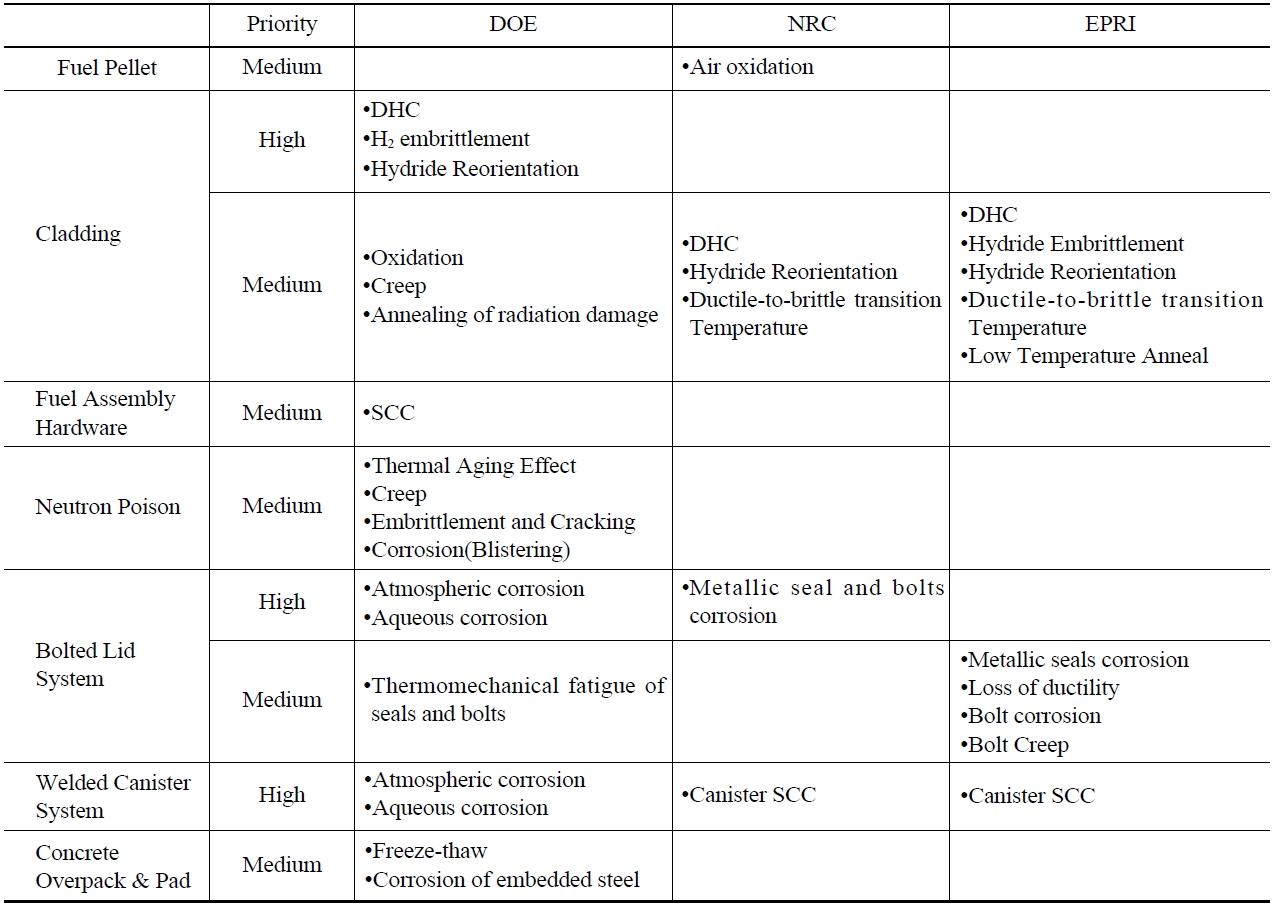
Summary of Technical Gap Analysis Results.
because of a technical problem [29]. As the RRP cannot handle its expected capacity of 800 tU per year in 2010, the spent fuel accumulation problem in Japan is becoming serious, and this situation led to a massive dry storage necessity until a successful reprocessing facility begin operation (Fig. 5) [30]. Following a successive small amount of dry storage operation at the Fukusima and Tokai sites, a large-scale (5,000 tU in two steps) AFR dry storage will be operated in Mutsu October 2013. [31].
[Table 4.] Chronological Test Informaion.

Chronological Test Informaion.
[Table 5.] Detailed Test Information on Creep and Hydride Reorientation.
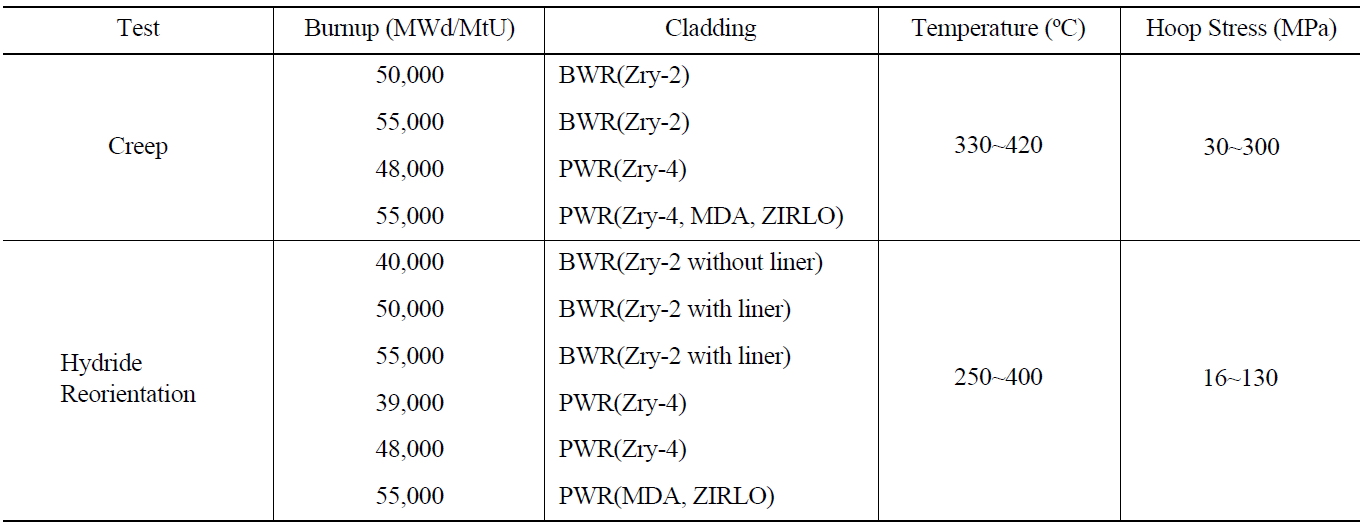
Detailed Test Information on Creep and Hydride Reorientation.
2.2.1 Methodology of Spent Fuel Integrity Evaluation
The ultimate objective of spent fuel storage in Japan is to keep its integrity by disallowing a failure due to thermal creep and a loss of mechanical properties due to cladding degradation. Spent fuel integrity research for only one rod has been performed for about 20 years at the Central Research Institute of Electric Power Industry (CRIEPI). It was concluded that there was no significant problem with this test rod [32]. A small amount of dry storage at the Fukusima and Tokai sites can be installed based on the above results for spent fuel integrity. However, a new largescale necessity of dry storage has led to a more distinctive concept. The main idea of dry storage in Japan is a ‘Holistic Approach’, which means no opening of a cask lid until the reprocessing step using a Dual Purpose Dry Metal Cask (DPDMC) for 50 years of storage and transportation to the reprocessing facility [33]. To implement this, a new need for their own technical criteria for dry storage has arisen. For spent fuel integrity criteria, the Japan Nuclear Energy Safety (JNES) supported by the Nuclear and Industrial Safety Agency (NISA) has studied thermal creep, hydrogen distribution & hydride reorientation, and irradiation hardening & recovery using various burnup range spent fuels for about 10 years [34]. Table 4 shows chronological test information including a single effect test item and spent fuel species. More detailed test information on creep and hydride reorientation is summarized in Table 5.
In the results of the creep test, the transition threshold strain for the irradiated cladding was much larger than 1 %, and therefore the usual criteria of 1 % creep strain may be a sufficient engineering margin for thermal creep single effect. This means that thermal creep is not a significant degradation mechanism for spent fuel cladding in dry storage conditions. For the results of irradiation hardening & recovery, nothing special has been pointed out. Regarding the hydride effect test, it was reported that cladding, which did not have any reoriented hydride, suffered ductile degradation. This fact induced a more extensive and conservative criteria, which does not allow degradation of cladding for mechanical properties and material ductility, while the USA only restricts the condition of hydride reorientation occurring. Based on these results, Table 6 shows the conclusive safety criteria of spent fuel integrity with regard to ductility degradation.
[Table 6.] Safety Criteria of Spent Fuel Integrity in Japan.

Safety Criteria of Spent Fuel Integrity in Japan.
[Table 7.] Fuel Assemblies for a Demonstration Test.
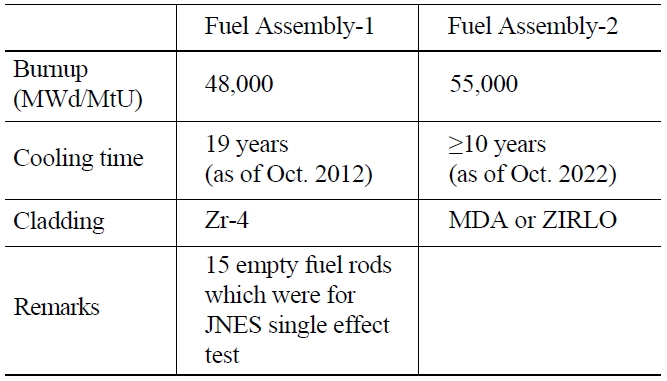
Fuel Assemblies for a Demonstration Test.
Compared to the USA, which uses uniform criteria (400 ℃) for zirconium-based alloy cladding, various temperatures dependent on fuel type, cladding material, cladding inner liner, and burnup will be applied to the new massive dry storage system in Japan. Another distinction is a hoop stress restriction, which is applied with temperature in two dimensions compared to the USA, which uses only one restriction (temperature or hoop stress). These conservative criteria demand a dry storage system with a much higher cooling efficiency, and could be applied to the new Japanese dry storage systems, which are all metal cask types.
2.2.2 Long-term Demonstration Program
The Nuclear Safety Commission (NSC) which is in the highest position among Japanese nuclear organizations, has recommended several utilities to perform a long-term spent fuel integrity demonstration program to accumulate the knowledge & experience of PWR spent fuel dry storage, confirm the long-term integrity of spent fuel, and finally convince people of safety. It is because the previous dry storage systems were only for BWR spent fuels [35]. Two assemblies will be installed in this demonstration system, and their basic information is summarized in Table 7.
This demonstration test has focused on only spent fuel integrity, not the dry storage system. Spent fuel integrity will be periodically checked by a visual test before installation and by a Kr-85 inspection with temperature and pressure gauging on the cask lid. At the end of the 60 year demonstration, only a visual inspection is planned for the final spent fuel integrity for now. This demonstration is expected to show the public the reliability of the spent fuel integrity in real time and to reach a more positive consensus on long-term spent fuel dry storage.
3. FORWARD DIRECTION OF SPENT FUEL INTEGRITY EVALUATION IN KOREA
3.1 Inevitable need for Spent Fuel Dry Storage
Though the expectation time of spent fuel pool saturation was recently estimated as the middle of the 2020’s, which is about 10 years later than the previous analysis, other solutions for the spent fuel accumulation problem such as the pyro processing and the direct disposal do not seem to be implemented at a commercial scale until that time. Therefore, spent fuel dry storage is an inevitable option in Korea in the near future, and has to be implemented within a spent fuel management master roadmap of the national policy. Considering the above two leading country cases, the criteria for spent fuel integrity is dependent on the national policy for spent fuel management and the main concept for restriction target and range. Likewise, a national policy of Korea on spent fuel management should be chosen first, and various boundary conditions of dry storage such as installation location, operation time, target spent fuel range and storage system types should then be determined considering public hearing. Based on the above policy and boundary conditions, a spent fuel integrity evaluation has to be performed to ensure that the domestic spent fuels to be stored in any dry storage system can keep its integrity for the given lifetime. The characteristic test data of domestic spent fuel is essential for this evaluation and could have a significant influence on the dry storage system design as a key factor. As this data acquisition demands lots of time and effort, it should be
implemented far before the storage system design. Fig. 6 helps us understand the necessity of spent fuel test data acquisition and an integrity evaluation ahead of the system design and operation.
3.2 Review on Previous Data and Production of Test Data
Even though the major characteristics of spent fuel needed for dry storage are the initial enrichment, decay heat, burnup, and cooling time, the operation history in the reactor is very critical for a detailed spent fuel integrity evaluation. According to the fuel performance code (FRAPCON-III) output, the burnup history in each operation cycle in a reactor has a significant influence on the final material properties of spent fuel, such as the oxide layer thickness and hydrogen pickup fraction for the same burnup condition. For example, Fig. 7 shows that spent fuel, which has been burned quite significantly in the first and second operation cycles (case 5, case 7), has a thicker oxide layer and more hydrogen concentration than the other cases (especially case 4) [36] .
In this context, the greater than 90% capacity factor of
Korean nuclear power plants compared to the less than 80% as the world average [37] (especially before 2000) is concerned for the final spent fuel conditions (Fig. 8) because there is still no evidence or test data to confirm that those high capacity factors do not have any significant effect on spent fuels which are considered as the first dry storage target, even though this is a very impressive achievement from a reactor operation point of view.
Therefore, it is necessary to produce domestic spent fuel test data to confirm the similarity with the results from other countries, and to analyze more detailed causes of discrepancy if they show a different tendency. Creep and hydride reorientation mechanisms of the cladding are the most important test items for this purpose [38]: the former is needed to satisfy the pre-existing well-defined safety criteria in the advanced countries, and the latter is representatively needed to check the decrease of cladding ductility due to the hydrogen effect, which has become a significant issue recently [39].
3.3 Development of Spent Fuel Integrity Evaluation Code
As it is very difficult to inspect or test all spent fuels to be stored, the final spent fuel condition in dry storage should be estimated using several codes. There are four kinds of codes that can support this estimation: a fuel performance code for the final anticipated material conditions of spent fuel in a pool, a nuclide depletion code for the radiation level and decay heat of spent fuel, a thermal analysis code for temperature history on cladding, and an integrity evaluation code for the final anticipated condition of spent fuel in dry storage by comprehensively using the other codes’ outputs as inputs [40]. The last one may consist of several engineering models, which have to be updated with validated & verified spent fuel test data to ensure the retrievability after storage.
3.4 Foreseeable Path for New Demand
While Korea has faced PWR spent fuel dry storage in the beginning stage, advanced countries are considering long-term extended storage and preparing R&D topics on the transportability of high burnup spent fuel, the seriousness of the hydride effect in decreasing temperature conditions during dry storage, the behavior of new cladding materials that have been recently developed and the insufficiency of the drying process [41-42]. Therefore, it is highly recommended that a spent fuel evaluation for low burnup range has to attain the level of advanced countries as soon as possible, and new work on a high burnup range then needs to be developed into a collaborative companion. To do this, building a domestic spent fuel test database would be the first step [43].
The ultimate objective of dry storage is to keep retrievability of spent fuel during operation lifetime, and this objective requires a practical spent fuel integrity evaluation supported by hot test before its implementation in Korea. Developing a domestic methodology for the safety criteria is most important and urgent for successful dry storage, and therefore, it is necessary to refer to the achievements of the USA and Japan, who have developed different advanced approaches for integrity criteria according to their needs. Based on spent fuel experiment data, it is recommended to compare a domestic data range with foreign results, to build our own criteria, and to expand evaluation work into recently issued integrity problems by using a comprehensive integrity evaluation code.
